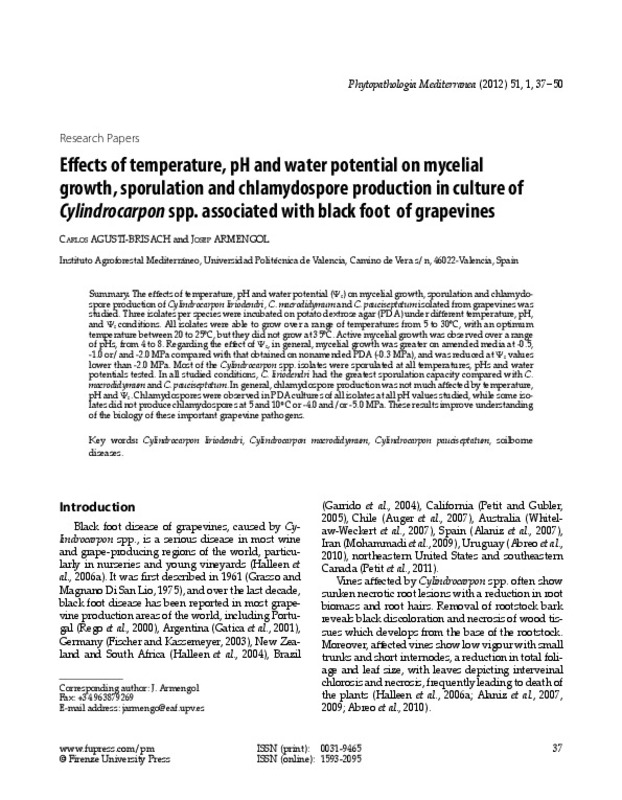JavaScript is disabled for your browser. Some features of this site may not work without it.
Buscar en RiuNet
Listar
Mi cuenta
Estadísticas
Ayuda RiuNet
Admin. UPV
Effects of temperature, pH and water potential on mycelial growth, sporulation and chlamydospore production in culture of Cylindrocarpon spp. associated with black foot of grapevines
Mostrar el registro sencillo del ítem
Ficheros en el ítem
| dc.contributor.author | Agustí Brisach, Carlos
|
es_ES |
| dc.contributor.author | Armengol Fortí, Josep
|
es_ES |
| dc.date.accessioned | 2016-09-02T06:46:57Z | |
| dc.date.available | 2016-09-02T06:46:57Z | |
| dc.date.issued | 2012 | |
| dc.identifier.issn | 0031-9465 | |
| dc.identifier.uri | http://hdl.handle.net/10251/68577 | |
| dc.description.abstract | [EN] The effects of temperature, pH and water potential (Ψs) on mycelial growth, sporulation and chlamydospore production of Cylindrocarpon liriodendri, C. macrodidymum and C. pauciseptatum isolated from grapevines was studied. Three isolates per species were incubated on potato dextrose agar (PDA) under different temperature, pH, and Ψs conditions. All isolates were able to grow over a range of temperatures from 5 to 30ºC, with an optimum temperature between 20 to 25ºC, but they did not grow at 35ºC. Active mycelial growth was observed over a range of pHs, from 4 to 8. Regarding the effect of Ψs, in general, mycelial growth was greater on amended media at -0.5, -1.0 or/and -2.0 MPa compared with that obtained on nonamended PDA (-0.3 MPa), and was reduced at Ψs values lower than -2.0 MPa. Most of the Cylindrocarpon spp. isolates were sporulated at all temperatures, pHs and water potentials tested. In all studied conditions, C. liriodendri had the greatest sporulation capacity compared with C. macrodidymum and C. pauciseptatum. In general, chlamydospore production was not much affected by temperature, pH and Ψs. Chlamydospores were observed in PDA cultures of all isolates at all pH values studied, while some isolates did not produce chlamydospores at 5 and 10ºC or -4.0 and/or -5.0 MPa. These results improve understanding of the biology of these important grapevine pathogens. | es_ES |
| dc.description.sponsorship | This research was financially supported by the Project RTA2010-00009-C03-03 (Instituto Nacional de Investigación y Tecnología Agraria y Alimentaria, INIA, Spain) and the European Regional Development Fund (ERDF). We acknowledge M. A. GarcíaMartínez and V. Garrigues for technical assistance and Dr D. Gramaje for providing valuable advice on the writing of this manuscript. | |
| dc.language | Inglés | es_ES |
| dc.publisher | Firenze University Press | es_ES |
| dc.relation.ispartof | Phytopathologia Mediterranea | es_ES |
| dc.rights | Reconocimiento - No comercial - Sin obra derivada (by-nc-nd) | es_ES |
| dc.subject | Cylindrocarpon liriodendri | es_ES |
| dc.subject | Cylindrocarpon macrodidymum | es_ES |
| dc.subject | Cylindrocarpon pauciseptatum | es_ES |
| dc.subject | Soilborne diseases | es_ES |
| dc.subject.classification | PRODUCCION VEGETAL | es_ES |
| dc.title | Effects of temperature, pH and water potential on mycelial growth, sporulation and chlamydospore production in culture of Cylindrocarpon spp. associated with black foot of grapevines | es_ES |
| dc.type | Artículo | es_ES |
| dc.identifier.doi | 10.14601/Phytopathol_Mediterr-9499 | |
| dc.relation.projectID | info:eu-repo/grantAgreement/MICINN//RTA2010-00009-C03-03/ES/RTA2010-00009-C03-03/ | es_ES |
| dc.rights.accessRights | Abierto | es_ES |
| dc.contributor.affiliation | Universitat Politècnica de València. Departamento de Ecosistemas Agroforestales - Departament d'Ecosistemes Agroforestals | es_ES |
| dc.contributor.affiliation | Universitat Politècnica de València. Escuela Técnica Superior de Ingeniería Agronómica y del Medio Natural - Escola Tècnica Superior d'Enginyeria Agronòmica i del Medi Natural | es_ES |
| dc.description.bibliographicCitation | Agustí Brisach, C.; Armengol Fortí, J. (2012). Effects of temperature, pH and water potential on mycelial growth, sporulation and chlamydospore production in culture of Cylindrocarpon spp. associated with black foot of grapevines. Phytopathologia Mediterranea. 51(1):37-50. https://doi.org/10.14601/Phytopathol_Mediterr-9499 | es_ES |
| dc.description.accrualMethod | S | es_ES |
| dc.relation.publisherversion | http://www.fupress.net/index.php/pm/article/view/9499 | es_ES |
| dc.description.upvformatpinicio | 37 | es_ES |
| dc.description.upvformatpfin | 50 | es_ES |
| dc.type.version | info:eu-repo/semantics/publishedVersion | es_ES |
| dc.description.volume | 51 | es_ES |
| dc.description.issue | 1 | es_ES |
| dc.relation.senia | 235976 | es_ES |
| dc.contributor.funder | Instituto Nacional de Investigación y Tecnología Agraria y Alimentaria |








